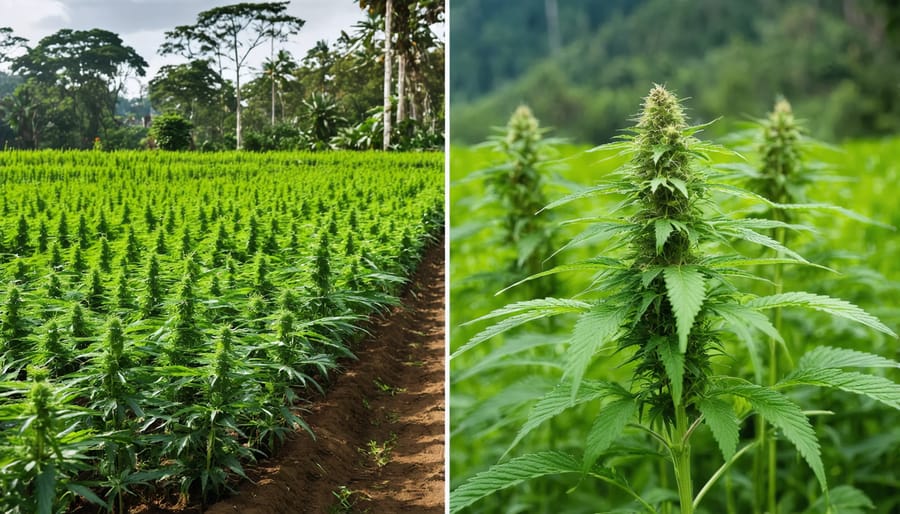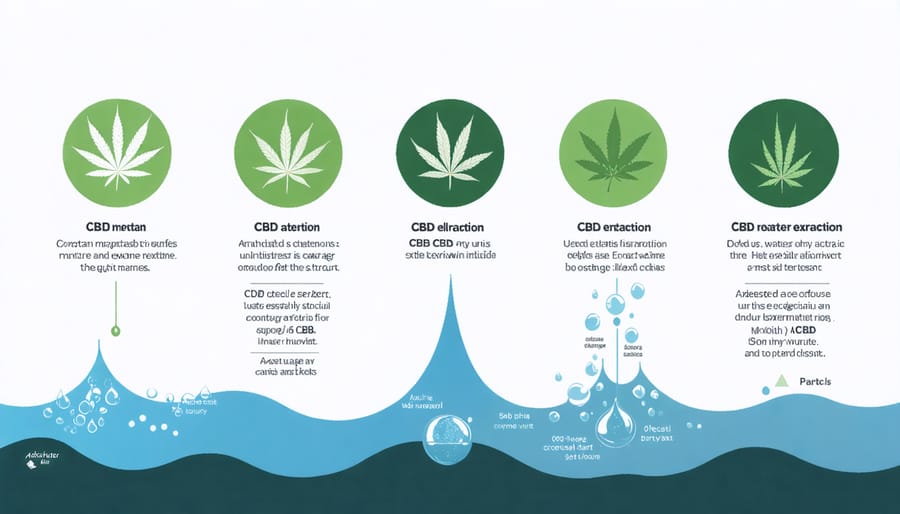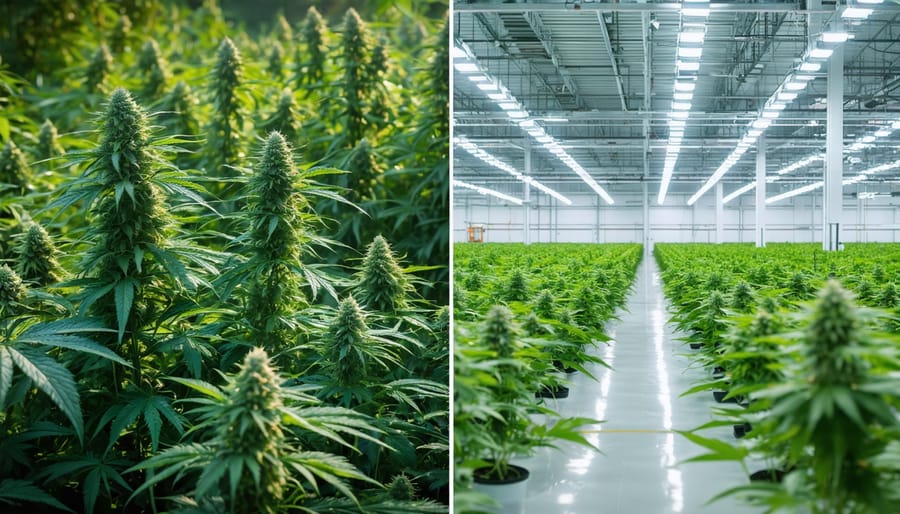Canada’s rapidly expanding CBD industry presents a complex environmental challenge that demands immediate attention. As CBDNorth Canada and other producers reshape the agricultural landscape, their environmental footprint raises critical questions about sustainability and ecological responsibility. From energy-intensive indoor cultivation facilities consuming massive amounts of electricity to water-intensive farming practices straining local resources, the industry’s growth intersects with Canada’s environmental commitments and Indigenous land stewardship traditions. Recent studies indicate that a single indoor CBD operation can produce the same carbon emissions as 900 homes, highlighting the urgent need for sustainable practices and regulatory oversight. This article explores the multifaceted environmental impacts of CBD production across Canada, examining innovative solutions emerging from collaboration between industry leaders, Indigenous communities, and environmental scientists to create a more sustainable future for this burgeoning sector.
CBD Production’s Environmental Impact on Canadian Soil
Soil Health and Biodiversity
The cultivation of CBD-rich cannabis plants significantly impacts soil health and local biodiversity across Canadian farmlands. Research indicates that cannabis plants, known as bioaccumulators, actively absorb heavy metals and other contaminants from soil. While this property can help cleanse contaminated lands, it also requires careful soil management practices to maintain ecological balance.
Indigenous communities have long emphasized the importance of sustainable cultivation practices that protect soil microorganisms. Traditional knowledge shared by First Nations farmers highlights the benefits of companion planting and crop rotation to preserve soil fertility and support beneficial insects and organisms.
Studies from Canadian agricultural institutions reveal that CBD cultivation can enhance soil biodiversity when managed properly. Organic farming methods, increasingly adopted by licensed producers, promote the growth of beneficial fungi and bacteria that contribute to soil health. However, intensive monocropping practices can deplete soil nutrients and reduce microbial diversity.
Local ecosystems also experience changes as CBD operations expand. Native plant species and their associated insect populations may be affected by large-scale cultivation. To address these concerns, many producers are implementing buffer zones around cultivation sites and incorporating pollinator-friendly plants into their operations, creating corridors for local wildlife while maintaining productive CBD cultivation.
Traditional Indigenous Land Management vs Modern CBD Farming
Traditional Indigenous land management practices offer valuable insights into sustainable CBD cultivation, emphasizing harmony with natural ecosystems and nature-based solutions. Indigenous communities have historically practiced companion planting, natural pest management, and water conservation techniques that minimize environmental impact while maximizing crop yields.
In contrast, modern CBD farming often relies heavily on intensive agricultural methods, including synthetic fertilizers, pesticides, and artificial irrigation systems. While these practices can increase short-term productivity, they frequently lead to soil degradation, water pollution, and reduced biodiversity.
Several Indigenous-led CBD farming initiatives across Canada demonstrate how traditional knowledge can be successfully integrated with contemporary cultivation needs. For example, the Three Sisters planting method – growing complementary crops together – has been adapted by some Indigenous CBD farmers to enhance soil health and reduce the need for chemical inputs.
Modern CBD operations are increasingly recognizing the value of these time-tested approaches. Some farms have begun implementing Indigenous-inspired practices such as natural buffer zones, seasonal planting cycles, and traditional crop rotation methods. This fusion of ancient wisdom and modern technology represents a promising path toward more sustainable CBD production in Canada.

Water Resources and CBD Processing
Water Consumption Patterns
Water consumption in CBD production varies significantly across different cultivation methods, with indoor operations typically demanding more water resources than outdoor or greenhouse facilities. Recent studies indicate that a single indoor CBD plant can require up to 22.7 liters of water per day during peak growing seasons, raising concerns about the impact on Canadian watersheds.
Traditional Indigenous farming practices offer valuable insights into water-efficient cultivation methods. Several First Nations communities have implemented water recycling systems and rainwater harvesting techniques in their CBD operations, demonstrating sustainable alternatives to conventional irrigation methods.
Hydroponic systems, while water-efficient through recirculation, present their own challenges. These systems typically use 70% less water than soil-based methods but require careful monitoring of water quality and mineral content. However, the energy required to maintain these systems often offsets their water conservation benefits.
Many Canadian CBD producers are adopting innovative water management strategies, including:
– Drip irrigation systems that reduce water waste by 20-40%
– Smart moisture sensors for precise water delivery
– Greywater recycling systems
– Drought-resistant plant varieties
These conservation efforts are particularly crucial in regions like British Columbia and Ontario, where increasing CBD production coincides with growing water scarcity concerns. Industry leaders are working with environmental scientists to develop best practices that balance production needs with watershed protection.

Wastewater Management Challenges
The processing of CBD extracts generates significant volumes of wastewater containing complex organic compounds, solvents, and other chemical residues that pose unique treatment challenges. Many Canadian CBD facilities struggle with managing these waste streams effectively, particularly in regions where existing municipal treatment infrastructure isn’t equipped to handle specialized industrial effluent.
Traditional water treatment methods often fall short in removing CBD-specific contaminants, leading to concerns about potential watershed contamination. Recent studies by Environment Canada have shown that untreated or inadequately treated CBD processing wastewater can impact aquatic ecosystems, particularly in sensitive river systems where many facilities operate.
Indigenous communities, particularly those downstream from processing facilities, have raised important concerns about water quality and traditional water use rights. The Mohawk Council of Kahnawake, for example, has worked with local CBD producers to implement innovative filtration systems that combine traditional knowledge with modern technology.
Several promising solutions are emerging across the industry. Advanced oxidation processes and biofiltering systems specifically designed for cannabinoid removal have shown success in pilot programs. The city of Medicine Hat, Alberta, has pioneered a public-private partnership model where CBD facilities pre-treat their wastewater before it enters municipal systems.
Industry leaders are also exploring water recycling initiatives, with some facilities achieving up to 60% reduction in freshwater consumption through closed-loop systems. These innovations not only address environmental concerns but also offer economic benefits through reduced water usage and treatment costs.
Energy Usage and Carbon Footprint
Production Facility Energy Demands
CBD processing facilities in Canada consume significant amounts of energy, primarily through extraction processes, climate control, and lighting systems. The most energy-intensive aspect is the CO2 extraction method, which requires maintaining precise pressure and temperature conditions. On average, a medium-sized CBD processing facility uses approximately 185,000 kilowatt-hours of electricity annually, equivalent to the energy consumption of 17 Canadian households.
Recent industry studies show that facilities implementing energy-efficient technologies have reduced their consumption by up to 40%. Several Indigenous-operated facilities lead the way in sustainable practices, incorporating traditional knowledge with modern green technologies. For example, the Six Nations of the Grand River facility uses solar panels to offset 30% of its energy needs while implementing smart climate control systems.
The challenge of high energy consumption has sparked innovation in the sector. Some facilities have switched to LED lighting systems and energy-efficient HVAC units, while others explore renewable energy solutions. However, the industry still faces criticism for its carbon footprint, particularly in provinces where the power grid relies heavily on fossil fuels.
To address these concerns, industry leaders are working with environmental organizations to develop sustainable processing standards, with some facilities achieving carbon-neutral certification through offsetting programs and renewable energy investments.
Renewable Energy Solutions
The CBD industry’s shift toward renewable energy solutions marks a crucial step in reducing its environmental footprint. Leading Canadian producers are increasingly adopting solar and wind power systems to offset the high energy demands of indoor cultivation facilities. Several Indigenous-owned CBD operations have pioneered sustainable practices by integrating traditional knowledge with modern green technologies.
Notable initiatives include the installation of smart LED lighting systems that reduce power consumption by up to 40% compared to conventional growing lights. Some facilities have implemented heat recovery systems that capture and reuse excess warmth from grow rooms, significantly decreasing overall energy requirements.
The Aurora Sky facility in Edmonton serves as a prime example, utilizing a hybrid power system that combines solar panels with energy-efficient greenhouse design. This approach has reduced their carbon emissions by an estimated 30% while maintaining optimal growing conditions.
Looking ahead, the industry is exploring innovative solutions such as geothermal heating and microgrids powered by renewable sources. These advancements, coupled with government incentives for clean energy adoption, position Canada’s CBD sector to achieve significant environmental improvements by 2030. Partnerships between producers and local Indigenous communities continue to drive sustainable practices, ensuring that environmental stewardship remains at the forefront of industry development.
Packaging and Waste Management

Current Packaging Practices
Current packaging regulations for CBD products in Canada require multiple layers of child-resistant and tamper-evident materials, leading to significant environmental concerns. Most CBD products are packaged using a combination of plastic containers, glass bottles, and additional protective materials, creating substantial waste in the industry.
The Cannabis Regulations mandate that packaging must be opaque or translucent and include specific warning labels, which often results in excessive packaging. A typical CBD oil bottle includes a glass container, plastic dropper, outer plastic container, cardboard box, and security seals. This multi-layer approach, while ensuring product safety and compliance, contributes to increased plastic waste and carbon emissions during production and transportation.
Indigenous communities have raised concerns about packaging waste affecting their territories, particularly in areas near production facilities. Some Indigenous-owned CBD companies are leading the way in sustainable packaging initiatives, incorporating traditional environmental stewardship principles into their business practices.
Several Canadian CBD companies are exploring eco-friendly alternatives, including hemp-based plastics, recycled materials, and biodegradable packaging options. However, these initiatives face challenges due to strict regulatory requirements and higher production costs. Some manufacturers have implemented take-back programs, allowing customers to return empty containers for proper recycling, though these programs remain limited in scope.
Industry experts estimate that packaging accounts for approximately 30% of a CBD product’s total environmental footprint, highlighting the urgent need for more sustainable solutions within regulatory constraints.
Sustainable Alternatives
The CBD industry is increasingly embracing sustainable packaging alternatives to minimize its environmental footprint across Canada. Leading producers are transitioning to hemp-based packaging materials, which offer a biodegradable solution while supporting the circular economy within the cannabis sector. These innovative containers break down naturally within six months, compared to traditional plastic packaging that can persist for centuries.
Several Indigenous-owned CBD companies have pioneered the use of traditional materials like birch bark and cedar-based packaging, incorporating ancestral knowledge into modern sustainability practices. These solutions not only honor cultural heritage but also demonstrate exceptional biodegradability properties.
Glass containers with recycled content have gained popularity, particularly when combined with refill programs that allow consumers to reuse their containers. Some retailers offer incentives for container returns, creating a closed-loop system that significantly reduces waste.
Mushroom packaging, developed from agricultural waste and mycelium, represents another promising alternative. This fully compostable solution requires minimal energy to produce and decomposes within 30-45 days. Several Canadian CBD companies have successfully implemented paper-based packaging made from post-consumer recycled materials and hemp waste, further reducing their environmental impact.
To address transportation emissions, companies are exploring concentrated CBD products that require smaller packaging and implementing local distribution networks. These initiatives, combined with eco-friendly packaging solutions, demonstrate the industry’s commitment to environmental stewardship while meeting consumer demands for sustainable products.
Legal Framework and Environmental Compliance
The regulatory landscape governing CBD production in Canada encompasses stringent environmental compliance standards designed to protect natural resources and ecosystems. Under the Cannabis Act and Environmental Protection Act, producers must adhere to specific guidelines regarding waste management, water usage, and emissions control.
Indigenous communities play a crucial role in shaping these regulations through consultation processes mandated by the duty to consult doctrine. Their traditional ecological knowledge has influenced policies on sustainable harvesting practices and land stewardship, particularly in regions where CBD cultivation intersects with traditional territories.
Key regulatory requirements include Environmental Impact Assessments (EIAs) for large-scale operations, waste disposal protocols for plant material and extraction byproducts, and water quality monitoring systems. Producers must obtain environmental permits and regularly report their compliance status to federal and provincial authorities.
Recent amendments have strengthened requirements for energy efficiency and carbon footprint reduction. Companies must now demonstrate sustainable practices through annual environmental audits and implement mitigation strategies for any negative impacts identified. Non-compliance can result in substantial fines, license suspension, or revocation.
The framework also emphasizes the importance of sustainable packaging solutions and encourages the adoption of circular economy principles within the industry. This includes requirements for biodegradable packaging materials and recycling programs for consumer waste.
To build a sustainable CBD industry in Canada, producers must adopt environmentally conscious practices while respecting Indigenous knowledge and traditions. Key recommendations include implementing renewable energy solutions for indoor cultivation, developing water recycling systems, and utilizing organic farming methods to protect soil health. Industry stakeholders should prioritize partnerships with Indigenous communities, incorporating their traditional agricultural wisdom into modern production methods. Certification programs for sustainable CBD production could help consumers make informed choices while incentivizing producers to minimize their environmental footprint. By combining innovation with traditional knowledge and establishing clear sustainability standards, Canada’s CBD industry can become a global leader in environmentally responsible production. Moving forward, government policies should support these initiatives through targeted funding and regulatory frameworks that promote sustainable practices.

